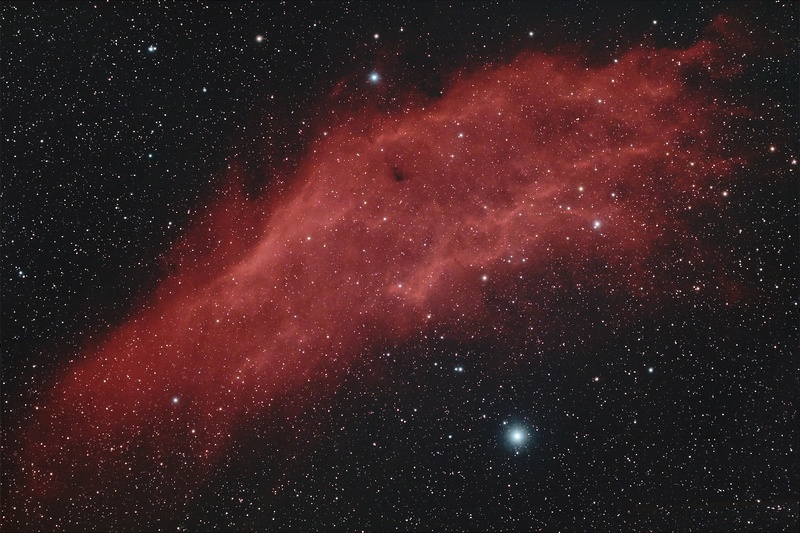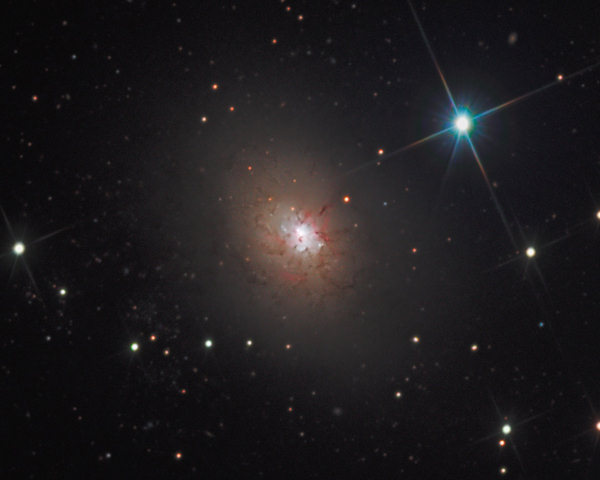Okay, so why is the Flame Nebula weird? It's because it is a weird color, and because the star ionizing it is off to one side.
So Alnitak, the ionizing star, is off to one side, and the Flame Nebula is a blob of thick dusty nebulosity completely detached from Alnitak. This is most unusual.
Normally, hot stars and their nebulas look like this:
Betelgeuse with Pickett's Bell, Lambda Orionis, Rosette Nebula
and a part of Barnard's Loop. Image: Miguel Claro.
So, let's talk about these "normal" nebulas. The Cocoon Nebula is being ionized by a single star, B1V-type
BD+46 3474, which has just been born from the nebula that it is now ionizing.
The Flaming Star Nebula is being ionized by O9.5V-type runaway star AE Aurigae, which is just passing through this particular dust cloud and lighting it up and ionizing it on its way through.
The California Nebula is being "snowplowed" into an elongated wall of gas and dust, and it is being ionized by the O7.5Iab runaway star Xi Per that is doing the snowplowing.
The amazing image by Miguel Claro shows Betelgeuse surrounded by a thin bell-shaped string of dust. We can also see the
Rosette Nebula at upper right. The Rosette Nebula is older than the Cocoon Nebula, and the cluster of stars have begun clearing away their birth nebula and ionize the dispersing bubble surrounding them. Near bottom is the
Lambda Orionis Nebula, which has been dispersed even further than the Rosette Nebula. Near the left edge of the picture is a part of Barnard's Loop. Near Barnard's Loop is a little yellow reflection nebula,
vdB 62.
But the Flame Nebula is a compact blob of gas and dust which is being ionized from outside by O9.5Ib star Alnitak and from the inside by the stars being born inside it, whose light is reddened to an orange hue by the surrounding dust:
So the Flame Nebula is being made to glow red from hydrogen alpha as Alnitak is ionizing it, but it is also glowing from inside from dust-reddened and therefore orange-tinted starlight.
I found a picture that actually reminds me of Alnitak and the Flame Nebula, and I can't keep it from you:
NGC 3077 and HD 86677 are nothing like Alnitak and the Flame Nebula. A galaxy is of course unimaginably larger and more powerful than a nebula (even if NGC 3077 is smallish), and HD 86677, which is located some 200 light-years from the Earth, is downright puny and unimpressive compared with Alnitak.
Still, this star-galaxy pair
looks much the same as Alnitak and the Flame Nebula. NGC 3077 has got a dusty center, just like the Flame Nebula, and hot young stars are being born there, just like stars are being born in the Flame Nebula, and the stars are being reddened by dust, just like the stars inside the Flame Nebula. And NGC 3077 is located to one side of foreground star HD 86677 in our skies. We might almost imagine that HD 86677 is actually ionizing NGC 3077, but it goes without saying that nothing like that is going on.
Ann
 Horsehead and Flame
Horsehead and Flame







